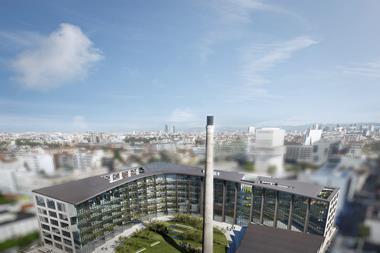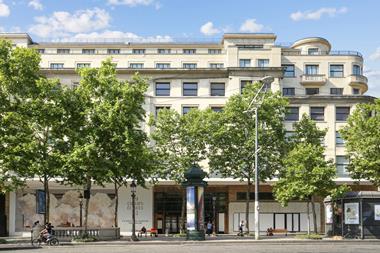The prognosis for US office is not good but it is not as bad as during previous downturns. What is worrying is that foreign investors are allowing the reports of the US housing market to colour their view of other sectors, including office. Stephanie Schwartz-Driver reports
Although the US office sector seems to have weathered the economic storms so far, it is not yet clear of danger, and some markets have suffered much worse than others.
US employment statistics paint a worrying picture for real estate investors. In May, total unemployment rose to 5.5%, with 49,000 job losses. Employment in professional and business services - typically white collar jobs, occupiers of office space - was down by 39,000 in May; accountancy and book-keeping services lost 10,000 jobs over the month. The business services sector has lost 124,000 jobs in 2008 alone.
Whether the US is in recession or just experiencing a severe downturn is a matter of semantics. What is interesting is that the office market has not yet shown the classic signs of a recession, notes Olin Needle, director, North American investment research at Heitman. "There is a sense of caution and apprehension in the marketplace. We are all waiting for the proverbial shoe to drop [that something expected will happen]," he says. However, the real danger signs, such as spiking vacancy rates or downward pressures on rents, have not emerged en masse, he noted.
Typically, in economic downturns, office has tended to suffer the most and to be the most volatile sector. In this economic cycle, this is not proving to be the case, pointed out Alan Billingsley, head of research, North America, for RREEF Alternative Investments. "This time, retail will suffer the most. Office is one notch up from retail." RREEF rates the apartment sector most favourably, followed by industrial, which is benefiting from its current stability.
The US office sector is set to suffer on two fronts. One is the supply-demand angle. Vacancy rates are projected to increase around 150 to 200 basis points nationally over the next two years as demand remains flat. And from the capital markets standpoint, the sector is going to see marked repricing. Nonetheless fundamentals are reasonably strong.
There are definite signs of hope, however, and many of these are revealed in a comparison of today's situation with the office market during the last economic downturn in 2001. "Overall there is not a supply problem, not like there was in 1990 or later in 2001," says Billingsley. "There is some new construction because the market looked so good two Another positive was pointed out by Olin Needle. "Outside of financial services, corporate balance sheets are in good shape. Companies are reluctant to hire, but they are also reluctant to fire. Given the high costs of hiring and training, there will be resistance to cutting workforces."
There have, however, been substantial job losses in financial services in New York City and environs (and consequent job losses in those fields that rely on the financial services industry), creating some pressure in midtown Manhattan. "The ten-year outlook there is now not as strong as it was," says Needle.
New York will experience something of a correction, agreed Billingsley. "Prices got a little bubbly there, and vacancies were so low. However, New York City will still look attractive on a national basis, with some easing in prices." The saga of the Macklowe deal, undone by the inability to refinance a deal based on short-term credit, has focused attention on the Manhattan real estate market. However, trophy properties such as the GM building will always attract willing buyers.
In partnership with Goldman Sachs, Kuwait, and Qatar, Boston Properties, Mort Zuckerman's group, bought the GM building plus three other prime Manhattan buildings this May for $3.95bn (€2.5bn). Of this, the GM Building went for around $2.9bn, setting a record price for a US office tower (the next biggest deal was the $1.8bn price tag for 666 Fifth Avenue achieved in 2007).
While New York City may be in for a correction, other markets are taking a more significant hit. Orange County, California, for example is one. It was the centre of the sub-prime industry and in addition, a number of large homebuilders were headquartered there. This region recovered the fastest after the 2001 downturn, but now is looking grim. "Orange County is attractive in the long term, because there is a lot of high-quality product there, but right now, the market is suffering," says Needle.
Given the multiple factors affecting the US economy, I'm concerned by all markets," says Paul Dougherty, president, Perseus Realty Partners, an opportunistic investor focused on buying either new developments or repositioning, rebranding and re-leasing older properties. Certain markets have prospects, he noted. One is Richmond, Virginia. "There are some interesting dynamics in Richmond, because a lot of companies have relocated there from the northeast for quality of life issues, lower cost of living, and because of the existence of an educated workforce."
Other southeastern cities are not as well positioned. Of Atlanta, Georgia, Dougherty says, "I would not touch it with a ten-foot pole. There is too much supply and not enough rent growth compared with cities such as Boston, New York, or Washington DC. It will continue to experience good population and decent job growth but its economy is not dynamic enough." Charlotte, North Carolina "will also feel some pain because of its exposure to the major banks that are going through well-publicised difficulties." And Raleigh-Durham, also in North Carolina, will not see the growth that will take place in areas with more diversified economies.
Alan Billingsley calls these southeastern sun-belt cities "the markets that we love to hate." Places like Atlanta, Dallas, Houston, Charlotte, and Raleigh-Durham are "subject to overbuilding normally, but are looking good now, because there is not a lot of supply coming on this time, compared with other economic downturns."
Among the sun-belt cities, Houston, Texas, is a good pick. "Houston has an economy unlike any other in the country because of oil. The Houston economy is somewhat counter-cyclical to the rest of the nation. In fact, developers are now building speculative product," says Dougherty. Austin also has interesting prospects. "Austin has a large tech base, it's the state capitol, it has a major university, and it has been showing strong rent growth," says Olin Needle. However, Billingsley added a note of caution. "We like Austin. So far the demand side has held up, but a lot of new supply is coming on line."
One market that Needle views favourably is Boston, Massachusetts. "This is a very strong market. Unlike the rest of the country, it is an active leasing market and is seeing more tenants looking for more space than is the norm in the USA right now."
Dougherty of Perseus is less positive about Boston, however, pointing out that a lot of jobs in financial services have been lost in the city and its environs. However, "Boston is not as active with new product as Washington DC is, for example," meaning that its underlying fundamentals are stronger than some major cities. In Washington DC, a lot of product is coming on line, just as demand is weakening.
RREEF makes a "strong call" in favour of San Jose, California, says Billingsley. "We continue to have a very bullish outlook. The reliance on tech is an asset in this cycle," he says.
San Francisco also gets positive ratings, with Dougherty pointing out that the city is experiencing solid demand and very good rent growth. Impressions of Los Angeles are more mixed: Dougherty points out that southern California in general is suffering from its exposure to the mortgage and home-building industries; Billingsley of RREEF says that "we are holding steady, with west Los Angeles in particular." Olin Needle classes San Francisco, Los Angeles, and even Chicago as "not bad".
Farther up the west coast, Seattle is another story. "We had liked Seattle a lot for a long time, seeing that it was benefiting from its diversified economy," says Billingsley. "But in this downturn, the momentum has dried up. It has been hit in the financial services contraction, with Washington Mutual, and there is significant new supply coming on line." However, he noted that "although Seattle will have a couple of weak years, in the long term, we take a positive view".
These are all major markets. The secondary markets - and even second tier locations in major metropolitan areas - are not really getting a look in these days. "There is almost no institutional investor interest in secondary cities, perhaps only some local or regional interest," says Billingsley. "A lot of properties are being taken off the market."
Overall, Needle sees a trend towards a huge bid-ask spread as buyers are reluctant to overpay. "It is a little like a stand-off," he says.
One sector that is benefiting from current economic conditions is central business districts. "We have been seeing a real shift in demand from more peripheral suburban markets to CBDs, infill, and urban markets," says RREEF's Billingsley. He attributes some of this revival in popularity to lifestyle factors, also saying that "high energy prices will accentuate the trend towards CBDs."
Despite rising travel costs, telecommuting will not represent a threat to office occupancy for now, says Billingsley. "Fuel costs may facilitate some increase in telecommuting, but this has never taken off, and I do not think we will see a major shift. Telecommuting does not work for corporate America."
Olin Needle of Heitman agreed. "CBDs are doing far better than suburbs or fringe office parks. He noted that most new supply that has come on line recently has been concentrated in the suburbs. "The strength today is in major downtown markets, particularly those tied to the global economy."
"As a core asset, US office in major markets is doing well and the underlying fundamentals are strong. Generally speaking, the suburban markets are the first to suffer when the economy turns downward," says Dougherty. "Urban office product is less of a commodity product - it is harder to build, there are more barriers to entry. Suburban office product is more of a commodity. You can easily add more supply in the suburbs."
One factor holding back international institutional investors, believes Dougherty, is misleading reporting of US real estate woes. "In the mainstream press, the lines are very blurred between residential and commercial," he explained. "At the end of the 1980s, we experienced a commercial real estate-induced recession. This time, the downturn began in the residential real estate sector and particularly the sub-prime mortgage industry. Commercial real estate has been pulled in inadvertently."
In part as a result of headlines in the press, "many Europeans have a more negative view of the situation than the reality would suggest. US commercial real estate markets are not suffering as much as people think. "The pain is not on the commercial side - the message is a little bit mixed," says Dougherty.
There are, however, key differences between residential and commercial, notes a recent review form Real Capital Analytics. These factors may well keep commercial prices from plummeting in the way that residential prices have.
Even though the office sector is in a stronger position overall than residential, it has been affected by the lack of liquidity from the public debt markets. "With a deficiency of higher leverage financial from the CMBS industry, combined with the lack of further cap rate compression, many large funds and investors find it extremely tough to deploy their capital," observed Dougherty. "In addition, it is extremely tough to finance deals over $100m. Lenders want to finance core and value-added deals, and buyers want to finance larger opportunistic deals. This disconnect is adding to the continuing gap between buyers and sellers. As a result, many funds are sitting on the sidelines. There are more people looking at our target size today," he observed. Perseus focuses in the middle market, from around $20m to $75m.












